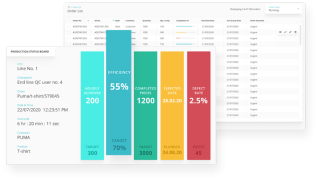8 key applications of Internet of Things (IoT) in fashion
Introduction
In a world where technology has infiltrated every aspect of our lives, fashion has emerged as an unexpected player in the realm of cutting-edge innovation. The marriage of fashion and technology has given rise to an exciting movement—the Internet of Things (IoT) is transforming the way we wear and experience clothing, unleashing a wave of creativity and functionality like never before.
What is the Internet of Things (IoT)?
The Internet of Things (IoT) is a network of interconnected devices that can collect, communicate, and exchange data without human intervention. In the context of fashion, IoT refers to the integration of smart devices, sensors, and connectivity into clothing and accessories, enabling them to collect and exchange data with other devices and systems.
According to a survey by the World Economic Forum, 92.1% of corporate leaders say that 10% of people will wear clothes connected to the internet by 2025. Once confined to the realm of sci-fi fantasies, smart clothing is no longer a mere figment of our imagination. Instead, it’s a tangible reality, woven into the very fabric of fashion’s future.
How The Fashion Industry Is Embracing Internet of Things (IoT)
The synergy of fashion and IoT is igniting a revolution, turning clothes into intelligent companions that cater to our needs, desires, and even health.
1. Wearable Tech: Smart Fashion on the Rise
The fashion world is no stranger to trends, but smart fashion is one that promises to stick around. From smartwatches that monitor heart rates to sneakers that track steps, wearable tech has become an inseparable part of our daily lives. The IoT-driven wearables market has exploded in recent years, attracting tech giants and fashion moguls alike.
Leading the charge have been fashion brands Levi’s and Yves Saint Laurent who have been early adopters of IoT creating collections of smart clothing and accessories with Google’s Project Jacquard. Picture a world where your dress changes colors according to your mood, or your handbag alerts you when you leave it behind – that’s the magic IoT brings to the runway.
2. Data-Driven Design: Fashion’s Next Frontier
Designing with data might sound like a sci-fi concept, but it’s now a reality in the fashion industry. IoT devices have provided designers with unprecedented insights into consumer behavior and preferences, enabling them to tailor their creations to meet evolving demands.
Imagine a designer receiving real-time feedback from a smart dress on the runway, analyzing how its movement and fit resonate with the audience. With this data, designers can fine-tune their collections to perfection, making fashion more responsive and personalized.
3. Smart Retail: A Shopping Experience Like No Other
Shopping has taken on a futuristic twist, thanks to IoT transforming brick-and-mortar stores into smart retail havens. Say goodbye to aimlessly wandering through endless racks and shelves and say hello to a seamless and immersive shopping experience.
Retailers like Levi’s have embraced IoT by deploying smart mirrors that allow customers to virtually try on outfits without stepping into a fitting room. Not only does this eliminate long queues and frustration, but it also ensures a contactless and hygienic shopping experience – a necessity in the post-pandemic world.
4. Sustainability Meets Technology: A Match Made in Fashion Heaven
The fashion industry’s love affair with IoT isn’t limited to aesthetics and convenience; it’s also about being eco-conscious. Sustainability is the new black, and IoT is lending a helping hand in reducing fashion’s environmental footprint.
By leveraging IoT, fashion brands can implement smarter supply chain management, optimizing production and reducing waste. IoT-enabled sensors can monitor resource consumption and identify inefficiencies, leading to a more sustainable and responsible fashion industry.
5. Fashion for Health: A Style Statement That Saves Lives
Fashion is not just about looking good; it’s increasingly about feeling good and staying healthy. IoT-enabled smart clothing is taking healthcare to a whole new level, making health monitoring an integral part of our daily routines.
Cyrcadia Health’s revolutionary iTBra, which detects early signs of breast cancer, has already made a significant impact on women’s health. Smart shirts capable of tracking vital signs during workouts have become gym enthusiasts’ go-to gear. The marriage of fashion and health through IoT is saving lives, one garment at a time.
6. Supply Chain Optimization: IoT’s Efficiency Boost
The fashion industry’s intricate supply chain has always been a challenge to manage efficiently. However, with IoT, fashion companies are reaping the benefits of improved supply chain optimization. IoT-enabled sensors and RFID tags are now tracking products from the initial stages of production to distribution centers and finally to retail stores.
Real-time data insights into the movement of goods and inventory levels enable companies to make informed decisions, reduce lead times, and minimize costly delays. With IoT streamlining the supply chain, fashion brands can ensure timely delivery of products, reducing the risk of stockouts and improving overall efficiency.
7. Counterfeit Prevention: Fortifying Fashion’s Identity
Counterfeit fashion products have long plagued the industry, damaging brands’ reputations and eroding consumer trust. Here’s where IoT steps in as a powerful weapon against counterfeiting. The integration of IoT technologies like NFC (Near Field Communication) chips and QR codes into products enables fashion brands to offer foolproof product authentication to their customers.
Consumers can now verify the genuineness of their purchases with a simple scan on their smartphones. This not only strengthens brand identity but also safeguards consumers from falling prey to counterfeit items. With IoT’s authentication measures, fashion brands can protect their intellectual property and build a loyal customer base rooted in trust.
8. Inventory Management: IoT’s Real-Time Revolution
The fashion industry’s battle with inventory management is a tale as old as time. Overstocking or understocking products can lead to significant financial losses. IoT-powered inventory management provides a much-needed solution to this challenge.
Using RFID technology, fashion retailers can now accurately track stock levels in real-time, both in warehouses and on the sales floor. This real-time visibility enables them to predict consumer demand more accurately and make data-driven decisions on restocking and replenishment. The result is a leaner and more efficient inventory management process that maximizes revenue and minimizes waste.
The Future of Fashion is Connected
The possibilities are endless when it comes to IoT’s applications in the fashion industry. From garments that adjust their temperature based on the weather to shoes that analyze your gait and recommend the perfect pair, we’re only scratching the surface of what’s possible.
As IoT technology continues to advance, we can expect even more mind-boggling innovations in the realm of smart fashion. Picture a dress that changes patterns in response to your heartbeat or a jacket that communicates with your smart home, adjusting the thermostat as you step outside.
However, with great innovation comes great responsibility. As fashion designers and tech wizards collaborate to revolutionize the industry, they must also address privacy and security concerns associated with wearable tech. Safeguarding personal data and ensuring ethical practices will be crucial to building trust among consumers.
Final Thoughts: Embracing the Fashion-Tech Renaissance
As we step into a future where technology is seamlessly woven into the very fabric of fashion, we find ourselves at the cusp of a renaissance. IoT’s applications in the fashion industry have transcended novelty and become integral to our daily lives. From the runway to retail stores, from smart clothing to wearable health tech, IoT is undoubtedly the next big thing in the fashion world.
As designers, consumers, and tech enthusiasts alike, we have the opportunity to embrace this fashion-tech renaissance and unlock a world of style, functionality, and sustainability. The future of fashion is connected, and it’s up to us to shape this brave new world of smart fashion and redefine what it means to wear innovation






